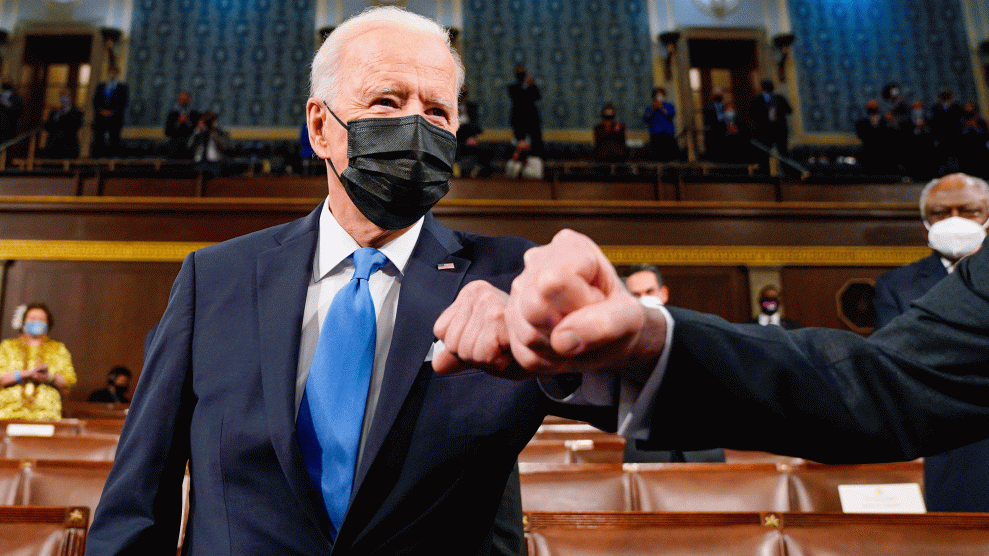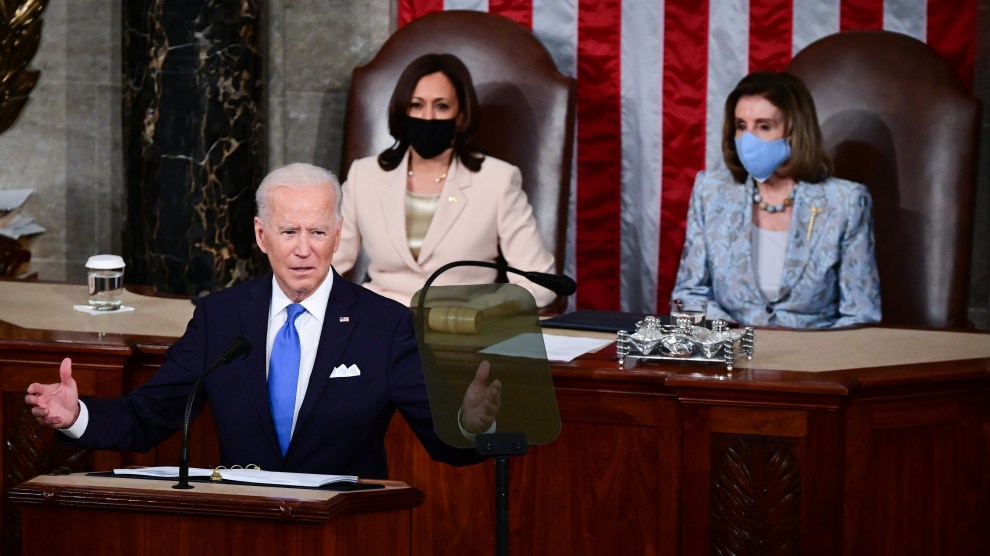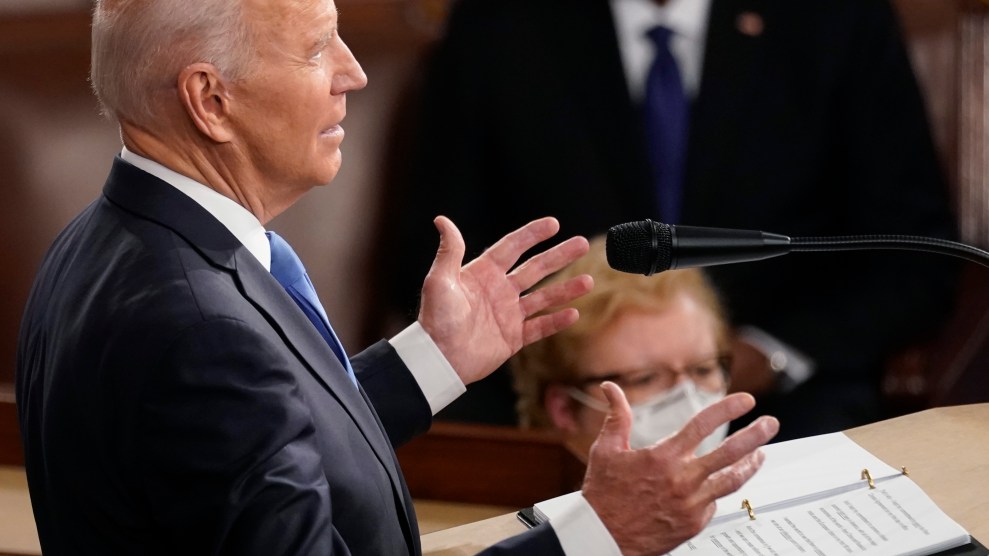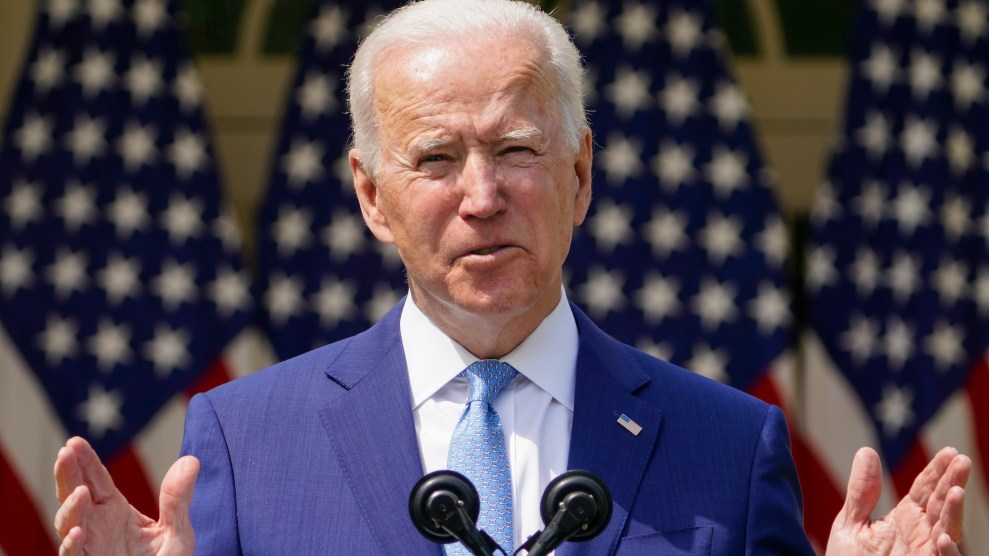
Melina Mara/The Washington Post via AP, Pool
In his 1981 inauguration speech, President Ronald Reagan proclaimed, “Government is not the solution to our problem, government is the problem.” Nearly four decades later, in his 2019 State of the Union speech, Donald Trump embraced a similar notion and equated calls for government activism with socialism: “America was founded on liberty and independence, and not government coercion, domination and control. We are born free, and we will stay free. Tonight, we renew our resolve that America will never be a socialist country.”
Yet the coronavirus crisis—and Joe Biden’s handling of it—has challenged these fundamental elements of conservative theology. In his first months in office, Biden has demonstrated that big government and perhaps a touch of socialism is crucial for the well-being of Americans and the United States. And he understands this. As he said in his speech to Congress on Wednesday night, “We have to prove democracy still works. That our government still works—and can deliver for the people. In our first 100 days together, we have acted to restore the people’s faith in our democracy to deliver. We’re vaccinating the nation. We’re creating hundreds of thousands of jobs. We’re delivering real results people can see and feel in their own lives.”
Actually, it was Trump who placed the nation on the road to this government-can-deliver lesson. Trump did botch the US government’s overall response to the pandemic. He never pushed for an effective testing regimen (despite promising at one point that a national testing system would be up and running within days). He repeatedly undermined the government’s own public health experts, especially regarding their recommendations for mask-wearing and social-distancing. He did not effectively use the authority and power of the federal government to supply the US health care system with all the personal protective equipment that was so desperately needed.
But the one area in which Trump fully flexed the muscle of the US government was a success: Operation Warp Speed, the program to swiftly develop vaccines for COVID-19. This government initiative worked. OWS was a partnership of the Department of Health and Human Services and the Defense Department that collaborated with pharmaceutical companies to accomplish the stunning feat of creating and manufacturing vaccines in record time. The Trump administration achieved this ambitious goal through the traditional means of big government: it threw money at the problem. The feds gave huge amounts to pharma companies to finance the vaccine development ($954 million to Moderna, $456 million to Johnson & Johnson) and even larger amounts in advance-purchase agreements with the companies to buy doses before they were even manufactured ($6 billion to Pfizer/BioNTech, $5 billion to Moderna, $1.2 billion to AstraZeneca, $1 billion to Johnson & Johnson). The advance-purchase deals created enormous incentives for the companies.
And there was more than money. A Government Accountability Office report noted others ways OWS assisted the pharmaceutical firms. It helped them identify additional manufacturing partners to increase production of vaccines. The US Army Corps of Engineers oversaw construction projects to expand capacity at vaccine manufacturing facilities. The feds expedited the procurement and delivery of critical manufacturing equipment to the vaccine companies. OWS officials sped up visas for key technicians and engineers working with manufacturers overseas.
It took more than a village to get these vaccines made. It took big government. And, certainly, the big-government spending of last year’s CARES Act—with its $2 trillion in coronavirus relief and stimulus money—kept the US economy from sinking further during the pandemic.
The Trump administration did fail in a basic component of Operation Warp Speed: the distribution of the vaccine. The first weeks of the rollout were marked by chaos, as Trump, at that time a lame duck president, focused more on the Big Lie that the election was stolen from him than on the mission of disseminating the vaccines and countering a deadly surge of COVID-19. Enter Joe Biden. Once he moved into the Oval Office, he and his team demonstrated that a federal government run by competent officials can do immense things in the right way. Within weeks, the US mass vaccination program became one of the best in the world. And it has zipped along to the point where now vaccine hesitancy might be more a challenge than vaccine production and distribution.
The American public has noticed. Almost two-thirds approve of Biden’s handling of the pandemic—more than twice Trump’s approval rating on this front.
The COVID vaccination program is Exhibit A that large-scale activist government not only can do the job; it is essential. The federal government encouraged the development of the vaccine, and it has been picking up the cost for it. The shot (or shots) are free to all. As the CDC notes, “The federal government is providing the vaccine free of charge to all people living in the United States, regardless of their immigration or health insurance status.” The take-away is obvious: the market, on its own, did not safeguard the public. It was up to the government to supply the necessary protection. A free dose for all regardless of the ability to pay? Some might call that socialistic.
Biden, as many have noted, has spent his first 100 days as president acting in a bolder and more progressive manner than might have been expected. He has proposed three huge packages of pandemic relief, economic stimulus, infrastructure development, and expanded social programs that total about $6 trillion. These proposals seek to expand government action to confront the consequences of the pandemic, income inequality, persistent poverty, crumbling infrastructure, systematic racial and gender inequities, stagnant wages, and more.
His American Rescue Plan, which was signed into law in March, increased unemployment assistance and included tax credits that are projected to raise millions of children out of poverty. His proposed American Jobs Plan, which made “infrastructure week” a real thing, would rebuild 20,000 miles of road, repair bridges, eliminate lead pipes from the nation’s water supplies, expand broadband, and finance a shift to cleaner energy sources—and create millions of jobs. In his speech to Congress, Biden boasted this is the “largest jobs plan since World War II.”
The American Families Plan Biden proposed in that speech aims to establish universal pre-school education and provide all American students two years of free community college. It also expands access to child care, enhances Obamacare, and mandates paid family and medical leave. And to pay for all of his new initiatives, Biden has not been shy in proposing tax hikes that only hit the well-off and corporations. He also wants $80 billion to revive and build out the IRS so it can capture about $800 billion from tax cheats.
Whether Biden anticipated this when he began his third run for the presidency, his message is now clear: This is the moment for government to go big. And that does mean taxing the wealthy more so these priorities can be sufficiently financed. This is the approach that Republicans and right-wingers have traditionally denounced as socialism and big-government-running-amok. And in recent weeks they have started revving those engines. Hours before Biden’s Wednesday night address, the Republican Party zapped out a fundraising email exclaiming that Biden’s address shows he has “fully embraced the radical socialist left of the Democrat Party.” After the speech, Sen. Tim Scott (R-S.C.), delivering the Republican response, decried Biden’s plans as “big-government waste” and dismissed them as “Washington schemes and socialist dreams.”
Still, the retrogressive opposition is stuck trying to whip up an old bugaboo in the face of recent and super-sized government initiatives that have been mostly successful. The vaccination program is a potent reminder that government health care can work—and that there are critical services for the citizenry that require government intervention. (See Medicare and Medicaid.) The massive economic stimulus of the past year undoubtedly prevented a deeper contraction and kept millions of Americans employed and afloat (as millions of others suffered tremendously). The market and the private sector did not save the US economy,
With these examples, Biden and the Democrats are well positioned to champion and advance the argument for big government. (They know not to call it socialism.) In the past year, government has been a huge part of the solution to the deadly crisis and the massive problems the nation has confronted. And the 46th president, by competently overseeing the vaccination program, has given the case for government a big shot in the arm.

















